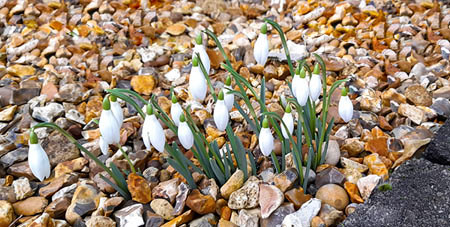Snowdrops, of which there are some 20 varieties identified of this bulbous perennial herbaceous plant; begin flowering in January. Almost every year this little flower lifts our spirits, informing us that Spring is just around the corner.

However, what is not commonly known is that there is very much more to our simple dainty snowdrop, than just meets the eye.
These small white drooping bell shaped flowers with their six petals, more properly identified as ‘Galanthus‘, (from the Greek meaning “Milk Flower”) can be found spread throughout Europe and the middle East and are not actually native to Ireland. The first human record of snowdrops was recorded by the Greek author Theophrastus, recorded in his book “Peri phyton historia” ( from the Greek, meaning “Enquiry into Plants”).
Snowdrops were possibly introduced into England by the Romans and later into Ireland during the early Plantation of Ulster in the 1600’s.
The presence of snowdrops is known to effective in pest control, as it contains a chemical called ‘Galanthus nivalis agglutinin‘ (GNA), latter known to possess a broad range of biological functions such as anti-tumour, anti-viral and anti-fungal activities.
Snowdrops are effective in deterring and possibly killing off small destructive sap-sucking insects like aphids (greenfly) and also nematodes (roundworms). Try growing them under your rose bushes.
Currently elements found in snowdrop are being used for the treatment of cognitive decline in mild to moderate Alzheimer’s patients and various other memory impairments, and also in treatments connected to post-polio paralysis and other neurological problems.
Snowdrops don’t often, if ever, multiply from seed here in Irish gardens due to our cold climate, latter which deters insects in coming out to assist with pollination. However, they will multiply by bulb offsets at the edge of their basal plate, with the original mother bulb nourishing them as they grow. After a couple of years, these small clumps of bulbs will enlarge to become quite dense and clumps can be split to be replanted elsewhere.

Leave a Reply